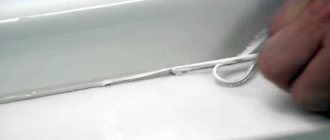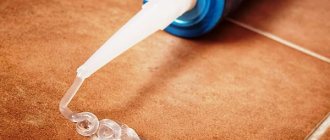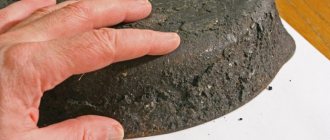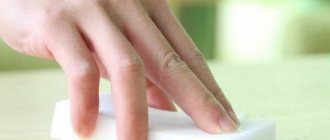As a rule, when working with silicone sealant, IZ products are used. But there are situations when, while observing safety measures, the substance still gets on the skin. It is more difficult to remove sealant from your hands than from clothes. There you can experiment and use strong substances, but you can’t do that with skin.
Dangerous influence of sealant
Silicone acryplast is a product of chemical origin, so do not delay its removal from the dermis. If this material is often used, then no matter how protected it is, a small part can still get in.
Removing sealant in its frozen form is more difficult and more dangerous, since it can eat into the skin. It is especially difficult to clean the sensitive skin of the fingertips.
People who suffer from allergic reactions should use such substances with extreme caution, as exposure to acetic acid and synthetic substances can lead to unpredictable reactions.
If you have cleaned the skin at home and painful marks remain, it is better to consult a doctor about further elimination of the wound.
Sunflower oil
It is not suitable for all types of sealants, but it usually works well with silicone. Take regular vegetable oil and heat it a little in a saucepan. You don’t need to use a lot of oil, about 50-100 grams is enough. Don't heat the oil too hot or you will burn your hands. After heating, apply the oil to your hands.
Oil alone will not remove the sealant. You need to add a little washing powder. You can completely wash your hands with it or just wipe off areas with sealant stains. The latter option is more preferable, since modern powders are very caustic. After traces of contaminants have disappeared, you should thoroughly wash your hands with running water.
Methods and means of removing sealant
It is problematic to wash off silicone sealant from your hands, since it is quickly absorbed through the pores and has a short hardening time. Therefore, before working with silicone acryplast, you need to stock up on rags in order to immediately remove dirt.
Based on their composition, the masses are divided into polyurethane and acrylic. Each type has its own method of cleansing.
Soap and plastic bag
Sealing materials interact with polyethylene. This type of material is always on hand in the form of a store bag.
This means is used for wiping, just like with a rag. If the mass has not yet hardened, it will begin to roll under the influence of polyethylene. Residues are washed off with soapy water.
Solvents
Solvents are good at removing contaminants from work surfaces, including removing paint and sealing elements. Acetone is considered the best cleaning agent.
The acetone method is not used if the dermis contains open wounds, cuts, irritations, burns.
For the cleaning procedure you will need a dry cotton rag. It is generously moistened with acetone, and the contaminated skin area is treated.
Soap and plastic bag
Not the fastest or most convenient, but quite effective method.
The algorithm of actions is simple:
- Rub your hands over the plastic bag until the sealant begins to stick to it.
- When most of the sealant sticks to the bag, wash your hands well with soap and water. It is better to use laundry soap.
- Repeat the procedure until the silicone is completely washed off.
- After cleaning, wash your hands thoroughly with toilet soap.
This method is only suitable for cases where the sealant has not yet completely hardened and its consistency is still viscous.
The nuances of removing silicone sealant from hands
It is worth considering some nuances when cleansing:
- For cleaning, several options are prepared at once; if one is not cleaned effectively, then immediately move on to another.
- The sealant is a toxic substance that is cleaned immediately before deep penetration into the epidermis, which can lead to irritation, burns, etc.
- If painful sensations appear, then you should not resort to dish soap or a washcloth, they will only aggravate the situation, making the penetration of acryplast even deeper into the skin of the hand.
Solvents
You can use acetone or gasoline as solvents. If pure acetone is not available, you can resort to nail polish remover, preferably colorless. You can also use regular paint thinner. These products have a strong odor and toxicity, so it is better to wash your hands outside, on a balcony or in a well-ventilated area.
- Apply the product to a cloth or cotton pad.
- Gradually scrub away dirt. There is no need to apply much force as the solvent may damage the skin.
- After cleaning, wash your hands well with toilet soap. It is better to spend a few minutes on this to completely rinse off any remaining solvent.
Useful tips
You should not use unfamiliar methods; keep in mind a few recommendations:
- Immediately after contamination, wipe the area with a lint cloth.
- Use gloves when working.
- To prevent the silicone sealant from sticking to the epidermis of the hands, they are first soaked in dish balm and dried.
- After work, hands are washed with soapy water.
- After cleansing, the skin requires moisturizing (castor oil, baby cream).
- If the contamination is thick, then before removal it is well saturated with products and then washed.
Chemicals for cleaning
White spirit will help you wash your hands.
So how can you wash silicone off your hands? There are specialized removal products that can be purchased at specialized stores. Below we will talk about the most used of them:
- Wipes are used that are designed to remove the types of contaminants in question from hands, baths or tiles. They are disposable. It is recommended to stock up on them before starting work.
- You can buy mineral spirits at hardware stores, which is a good cleaning method in a variety of conditions. Amine, amide, oxide and alcohol types of solvents can also be used to remove silicone. They can also be used to clean bathtubs or tiles.
- Acesolve PUN can be used to clean polyurethane sealant. This is one of the options for cleaning sealant.
- Dow Corning OS-2 is suitable for cleaning acrylic or silicone.
- To remove such dirt from the skin, using any dishwashing detergent can help. It combines effectiveness and complete harmlessness.
Important! The use of solvents can be harmful to the skin. Therefore, it is necessary to limit the contact time of such substances as much as possible. After cleaning, wash your hands thoroughly with warm water and soap.
If you remove the sealant immediately after contact with the skin, bathtub or faucet using a damp cloth, there will be no need to use specialized products.
It is possible to use hydrophobic creams during work. If you smear your hands thickly, the sealant will not stick to them. After completing the repair work, they must be washed off.
Steaming, pumice stone and laundry soap
With sufficiently strong heating, the silicone that has not had time to completely harden softens, and it becomes easy to scrub and wash it from the skin using mechanical action, for example, using pumice. This is done like this:
- Water is poured into the basin at such a temperature that it almost burns your hands, but at the same time you can endure it, as in the case when you soak your feet when you have a cold.
- Immerse your silicone-stained hands in water and steam them for about five minutes.
- Then wash them under warm (almost hot) water under a tap with laundry soap, while scrubbing off dirt with a pumice stone.
Some consider this option to be the most effective. Just don't be overzealous. If you use pumice stone and silicone for a long time, you can also “clean off” the top layer of skin from your hands. The area will subsequently hurt and even become covered with scabs. Therefore, you need to be more careful with pumice.
How to get rid of sealant on clothes
- treat the stain with a solvent and iron it through a layer of paper;
- Traces of fresh glue-sealant are removed by soaking clothes in hot water. Since silicone is destroyed by high temperatures, the chances of removing the stain this way are high. If the stain is dry, first resort to a solvent;
- for resistant fabrics, a brushing procedure is used;
- If the stain has not yet been absorbed, then you should lift the contaminated fabric, stretching it slightly. Then place in the freezer for 2 hours. Temperature changes are detrimental to these substances; they are easily scraped off;
- To clean stains on leather material (straps, cases, bracelets), use a home method: mix ammonia with water in equal parts and add soap.
How to wash it from clothes?
Very often, clothes are subject to the adhesion of silicone glue. Unlike other substances, it cannot be washed off with any stain remover. Immediately after contact, immerse the fabric in hot water. The high temperature will soften the glue, making it easier to remove from the fibers. If it is not possible to immediately throw things into the washing machine, and the sealant has already hardened, then you will have to resort to already known solvents. You need to soak your clothes in them for half an hour, and then calmly wash the stain.
The solvent can ruin colored fabric, so it is advisable to resort to mechanical cleaning. To do this, you will have to lay out your favorite T-shirt on a flat surface, and carefully, layer by layer, cut off the remaining mixture from the fabric to the very base. The solution deeply embedded in the fibers is scraped out with a brush or pumice. It would be a good idea to treat the residues with vinegar concentrate or other universal solvent, as well as gasoline or alcohol. Then, of course, it is better to wash the remaining softener in hot water.
Review of popular removal methods from various surfaces
Once on the surface, the sealant hardens quickly and is difficult to remove using conventional means.
Mechanical
pry the material with a knife or other sharp object and pull carefully; Scrape off the silicone using a metal scraper or spatula by scraping. The main part of the contamination is removed with a sharp object, then the surface is cleaned with a layer of sandpaper; The mechanical method is well suited for floor coverings (laminate). The above methods are suitable for dark surfaces that are highly resistant, otherwise you can remove the stain along with paint and acrylic
The above methods are suitable for dark surfaces that have increased resistance; otherwise, you can remove the stain along with the paint and acrylic.
Chemical
When using chemicals on a thick layer of sealant, pre-treat the seams with a rag with a remover.
The chemical substance is selected depending on its composition. There are one- and two-component silicones. Acidic ones are removed with concentrated vinegar or a solvent, alcoholic ones are removed with ethyl alcohol, neutral ones are dissolved with white spirit.
There is another classification of silicones.
- plumbing – used for sealing sanitary facilities: acrylic bathtub, shower stall;
- adhesive-sealant – used in the manufacture of glass and glass-ceramic products: aquariums, stained glass windows;
- silicones with antifungal additives - used in aquariums and swimming pools.
| Chemical name | Peculiarities |
| White Spirit | Consists of aliphatic and aromatic hydrocarbons. Use on unpainted surfaces, otherwise the sealant will be removed along with the paint. |
| Penta-840 | Universal solvent, used under any storage conditions and air temperature. Apply the substance to the required surface, wait until completely softened, and rinse with plenty of water. |
| Antisil | Silicone degreaser. |
| Dow Corning OS-2 | A product for removing substances from PVC and acrylic surfaces. |
| Silicon-Entferner | Removes from enamel, metal, plastic surfaces. |
| Lugato Silber Shutz Silicon | In addition to removal, it prevents the appearance of fungus and mold. |
Household methods
fresh stains are removed with a cloth soaked in soapy water. You can clean the brush by soaking it in warm detergent; the method of removal depends on its composition. Neutral seals are made on the basis of alcohol, alkaline – on the basis of alkali, acid – using acetic acid. To remove, soak the sealant in the material on which it is based; consider the type of surface. It is forbidden to treat wooden kitchen surfaces (countertops) with acetone or white spirit, metal ones with vinegar (to prevent corrosion); to get rid of silicone on ceramics, first treat with a solvent, and after half an hour rub the stain; The easiest way is to wipe off old stains from plastic. It is enough to soak the surface, after half an hour treat it with a solvent, then with a degreasing solution
Use acetone with caution on plastic, as there is a risk of it softening; removed from metal mechanically (use a knife or scissors); It is easy to wipe off traces of silicone sealant from glass if you preheat it; If the sealant needs to be removed from the tiles in the bathroom, pick it up with a sharp object and evenly, without sudden movements, remove the substance along the entire perimeter of the tile. If you are afraid of scratching the tiles with a sharp object, use a wooden scraper
Before applying a new sealant, first degrease the surface; wrap the salt in gauze and treat any type of silicone; Heat the required element with a hairdryer; the high temperature will cause the silicone to fall off on its own.
Products that should not be used with silicone
Degreasers, solvents, alkalis, and vinegar are incompatible with silicone, depending on the composition. Silicone sealant does not tolerate temperature changes and is destroyed by such exposure.
It is easier to prevent the appearance of sealant stains than to clean them up later. To prevent contamination, there are special tapes and solutions that prevent silicone from reaching surfaces. When working with chemicals, you should be careful and be extremely careful.
Alcohol
Alcohol is actually a universal solvent, suitable for cleaning not only sealants, but also the most durable adhesives. You can use ethyl or isopropyl alcohol. The latter is used for technical purposes. It is recommended to wash the skin with a cotton pad or cloth soaked in alcohol.
If the solution is already very hard, you can apply a little alcohol to it and wait until it softens. After this, use a cotton pad to gently wipe off the remaining sealant. Then your hands should be washed thoroughly with water to remove any remaining alcohol. You shouldn't rub your hands with alcohol for too long; it can dry out and even burn your skin.











